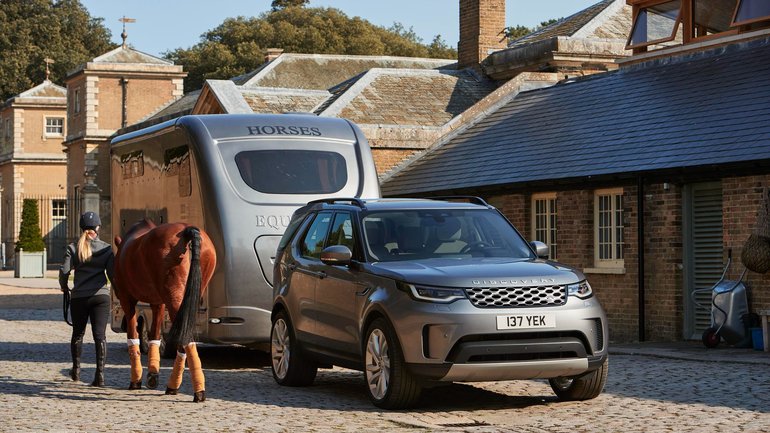Discovery's 3,500 kg Towing Capacity: What It Means for Quebec Adventurers
October 08 2025,

When you need to tow a boat to the Saint Lawrence, haul a camper to Gaspésie, or transport winter sports equipment to Tremblant, the numbers matter. The Discovery's 3,500 kg maximum towing capacity sits at the top of its segment, but the real value lies in how Land Rover's technology stack makes that capability accessible and confidence-inspiring across Quebec's varied terrain.
The Capability Foundation
The Discovery achieves its 3,500 kg towing capacity through the integration of several key systems. The 3.0-litre straight-six Ingenium P360 petrol engine features 48V Mild Hybrid Electric Vehicle (MHEV) technology, producing 360 PS (355 hp) and 369 lb-ft of torque between 1,750 and 5,000 rpm. This broad torque band provides the pulling power needed to move heavy loads from a standstill or maintain momentum on grades.
The Intelligent All-Wheel Drive system automatically distributes torque between the front and rear axles based on traction conditions. When towing, this system continuously monitors wheel slip and adjusts power delivery to maintain forward progress, particularly useful when launching a boat at a slippery ramp or navigating unpaved campground roads with a trailer in tow.
Advanced Tow Assist Technology
Reversing with a trailer remains one of the most challenging aspects of towing. The Discovery's Advanced Tow Assist addresses this by allowing drivers to control trailer direction using the central Pivi Pro touchscreen and the Terrain Response selector knob. You indicate the desired path for the trailer, and the system manages steering inputs to guide the vehicle and trailer along that trajectory.
The system displays responsive trajectory lines on the 11.4-inch touchscreen, showing the predicted path based on your inputs. This removes much of the guesswork from backing into tight camping spots or aligning a boat trailer with a narrow launch ramp. The technology works at low speeds, where precise control matters most.
Trailer Stability Technology
Once underway, Trailer Stability Assist actively monitors for trailer sway—the side-to-side oscillation that can occur at highway speeds, particularly in crosswinds or when passed by large vehicles. The system detects sway through sensors that measure lateral movement and vehicle dynamics.
When sway is detected, Trailer Stability Assist responds by reducing engine torque and applying controlled braking to specific wheels. This intervention happens gradually, slowing the vehicle and restoring stability without abrupt movements that could worsen the situation. The system allows you to maintain control while it works to correct the trailer's motion.
Quebec-Specific Applications
For boating enthusiasts heading to Lac Saint-Pierre or the Thousand Islands, the Discovery handles boats and trailers well within its capacity rating. A typical 6-metre boat with trailer weighs between 1,500 and 2,000 kg, leaving substantial margin within the Discovery's capabilities.
Families traveling to provincial parks with travel trailers find the Discovery well-suited to the task. Mid-size travel trailers typically weigh 2,000 to 2,800 kg when loaded, and the Discovery's towing capacity accommodates these loads while maintaining stability on autoroutes and secondary highways throughout Quebec.
Winter sports equipment transport presents another scenario where towing capacity proves valuable. Enclosed cargo trailers loaded with snowmobiles, skis, and gear can approach 2,500 kg. The Discovery manages these loads while navigating the challenging conditions often encountered on routes to popular ski areas.
|
Towing Specifications |
Discovery P360 |
|---|---|
|
Maximum Towing Capacity |
3,500 kg |
|
Maximum Coupling Point Weight |
150 kg |
|
Engine |
3.0 L straight-six petrol MHEV |
|
Power Output |
360 PS (355 hp) |
|
Torque Output |
369 lb-ft @ 1,750-5,000 rpm |
Electrically Deployable Tow Bar Features
The optional Electrically Deployable Tow Bar includes several useful features beyond the convenience of automatic deployment. Rear Height Adjust allows you to raise or lower the rear of the vehicle to align the tow ball with different trailer heights. This proves helpful when connecting to various trailer types without manual adjustments to trailer jacks.
Hitch Assist uses the surround camera system to help guide the tow ball to the trailer's coupling point. The touchscreen displays multiple camera angles, making it easier to line up the connection without a spotter. This feature reduces the time spent maneuvering back and forth to achieve proper alignment.
Nose Load Measurement provides a quick verification of tongue weight using either the central touchscreen or the Remote smartphone app. Proper tongue weight distribution affects both towing stability and vehicle handling, and this system removes guesswork from the loading process.
Real-World Towing Performance
On Quebec autoroutes, the Discovery maintains highway speeds with trailers attached. The straight-six engine provides adequate reserve power for passing and merging, while the eight-speed automatic transmission selects appropriate gears to maintain momentum on grades without excessive downshifts.
Secondary highways present more varied conditions. Routes like Highway 138 along the north shore or Highway 132 through the Gaspésie include grades, curves, and changing pavement conditions. The Discovery's air suspension system automatically adjusts for the additional weight of a trailer, maintaining ride height and stability throughout these varied conditions.
Hill Descent Control and Off-Road Towing

When navigating steep cottage access roads or boat launch ramps, Hill Descent Control provides valuable assistance. The system maintains a controlled descent speed without requiring constant brake pedal input, allowing you to focus on steering while the vehicle manages speed control.
This feature proves particularly useful at boat launches, where slippery surfaces and steep grades combine to create challenging conditions. The system works in conjunction with traction control to maintain steady progress both descending to the water and ascending back to dry pavement.
Winter Towing Considerations
Quebec winters add complexity to towing operations. The Discovery's winter capability features work alongside its towing systems to maintain control in snow and ice. The Terrain Response 2 system includes a Grass/Gravel/Snow mode that adjusts throttle response, traction control, and transmission behavior for reduced-traction conditions.
When towing in winter, these adjustments help prevent wheel spin during acceleration and provide smoother power delivery when pulling away from stops. The system also modifies brake distribution to account for trailer weight and reduced tire grip on snow-covered surfaces.
Practical Capacity Planning
Understanding actual trailer weights helps determine whether the Discovery suits your towing needs. Empty travel trailers typically weigh 60-70% of their gross vehicle weight rating (GVWR). A trailer with a 3,500 kg GVWR might weigh 2,200 kg empty, leaving 1,300 kg for cargo, water, and supplies.
For boat and trailer combinations, add the boat's dry weight, engine weight, fuel, gear, and trailer weight. A mid-size boat package might total 1,800 kg, while larger combinations can approach 2,500 kg. The Discovery handles both scenarios within its rated capacity, with room for passengers and cargo in the vehicle itself.
Mild Hybrid Technology When Towing
The Discovery's 48V MHEV system provides benefits during towing operations. The system harvests energy during deceleration and stores it in a 48-volt lithium-ion battery. This stored energy assists the engine during acceleration, which proves particularly useful when pulling away from stops with a trailer attached or maintaining speed on grades.
The belt-integrated starter motor enables smooth operation of the start-stop system, even when towing. The system recognizes when a trailer is connected and adjusts its behavior accordingly, maintaining engine operation when necessary for trailer stability and climate control.
Fuel Consumption Considerations
Towing affects fuel consumption significantly. Expect fuel economy to decrease by 30-40% when towing near the vehicle's maximum capacity at highway speeds. The Discovery's trip computer provides real-time fuel consumption data, allowing you to monitor efficiency and plan refueling stops on longer trips.
The P360's 3.0-litre engine balances power delivery with reasonable efficiency. The mild hybrid system helps recover some energy that would otherwise be lost, particularly during the frequent speed changes common in towing situations on Quebec's varied road network.
Safe Towing Practices
Proper weight distribution remains critical for safe towing. Aim for 10-15% of trailer weight on the tongue—too little creates instability, while excessive tongue weight affects vehicle steering and braking. The Discovery's Nose Load Measurement system helps verify this distribution.
Tire pressures require adjustment when towing. Consult the vehicle's tire pressure placard for towing-specific pressures, which typically increase compared to normal driving. Proper tire inflation helps maintain stability and prevents premature tire wear when operating near maximum capacity.
Technology Integration
The Discovery's towing capability integrates with its broader technology suite. Terrain Response 2 automatically selects appropriate settings for the driving surface, whether you're navigating a gravel boat launch or a paved campground road. The system monitors conditions and adjusts traction control, throttle response, and transmission behavior to suit the situation.
Adaptive Dynamics technology monitors vehicle movements up to 500 times per second, adjusting damper settings almost instantaneously. When towing, this system helps maintain stability by controlling body movements that could affect trailer behavior, particularly during lane changes or emergency maneuvers.
Cargo and Passenger Balance
The Discovery provides seven-seat capability while maintaining its 3,500 kg towing capacity. This allows families to transport both people and equipment without choosing between passenger capacity and towing ability. With all seven seats in use, the vehicle still provides 258 litres of cargo space—enough for essential gear and supplies.
For trips requiring maximum cargo space, folding the third-row seats expands capacity to 1,179 litres, while folding both second and third rows creates 2,485 litres of loadspace. This flexibility supports various trip configurations, from family camping expeditions to solo boat fishing trips.
Wade Mode and Water Crossings
Quebec's boat launches and cottage access roads sometimes involve water crossings. The Discovery's Wade Mode, accessed through Terrain Response 2, prepares the vehicle for fording up to 900 mm of water. The system raises the vehicle to off-road height, optimizes throttle and transmission settings, and provides real-time wading depth visualization on the touchscreen.
When towing a boat trailer, Wade Mode helps maintain control while backing down steep, slippery launch ramps. The system automatically applies the brakes gently when exiting Wade Mode, ensuring full braking performance is immediately available—important when controlling a vehicle and trailer combination.
Command Driving Position Benefits
The Discovery's elevated seating position provides excellent visibility when towing. This commanding view helps when monitoring trailer position during lane changes, checking mirrors for trailer sway, and assessing clearances in tight spaces. The large side mirrors, designed to accommodate trailer viewing, provide clear sightlines to the rear of longer trailers.
The stadium seating design means even second and third-row passengers enjoy good forward visibility, reducing the isolated feeling that can occur in vehicles with limited sight lines. This proves valuable on longer towing trips when maintaining passenger comfort matters for family harmony.
Practical Towing Scenarios
Weekend trips from Montreal to Lac-Mégantic with a 2,200 kg travel trailer demonstrate the Discovery's capability. The P360 engine maintains highway speeds on Route 112's grades, while the air suspension keeps the ride controlled and comfortable. Trailer Stability Assist provides confidence when passing transport trucks generate crosswinds.
Boat owners towing to Lac Saint-Louis find the Advanced Tow Assist particularly valuable. The system simplifies the tight maneuvering required at busy public launches, and Hitch Assist makes solo trailer hookup manageable. The Discovery's ground clearance handles uneven launch ramps without scraping.
Families towing utility trailers loaded with furniture or renovation materials appreciate the Discovery's refined ride quality. Unlike commercial vans or trucks, the Discovery provides car-like comfort and technology for the driver and passengers, while delivering the payload and towing capacity the task requires.
Learn More at Decarie Land Rover
Understanding how the Discovery's towing systems work together provides confidence for Quebec's diverse towing scenarios. Contact our sales team at Decarie Land Rover in Montreal to discuss how the Discovery's 3,500 kg capacity and advanced towing technology suit your specific needs.





